How To Play Guitar Without An Amp – Killer Guitar Rigs
To play an electric guitar without an amp, you can plug it into an audio interface connected to a computer or smartphone and hear the sound from headphones, speakers, or studio monitors. There are also other alternatives such as playing an electro-acoustic guitar or a guitar with a built-in amplifier.
One of the major obstacles budding electric guitar players often face is how loud the instrument can often be even when plugged into the lowest volume setting of an amp. Although Bryan Adams released a hit record called ‘Waking Up The Neighbours’ in 1991, it is very much frowned upon to do so. Especially when you are practicing for long hours.
If you have ever wondered how you can play your electric guitar without an amp, then read on to find out how you can do so.
Why Can’t My Electric Guitar Produce Sound By Itself?
The bodies of electric guitars are very different from acoustic ones. When you pluck the strings of an acoustic guitar, the vibrations from the bridge resonate throughout the body of the guitar. This resonance on the sides, back, and top of the guitar enables it to produce sound through the soundhole.
The construction of electric guitars is very different. For starters, they are generally solid-bodied. This means that the wood itself does not resonate any sound within it. When you pluck or strum the strings, the vibrations are converted to electric signals via the pickups and these are then converted to sound when plugged into an amp. So by themselves, electric guitars produce very little sound and the signal thus needs to be amplified.
How Can I Play An Electric Guitar Without An Amp?
Well, the good news is that you can still produce sound from an electric guitar without an amp. Here are some of the most common ways to do so:
PC or Mac
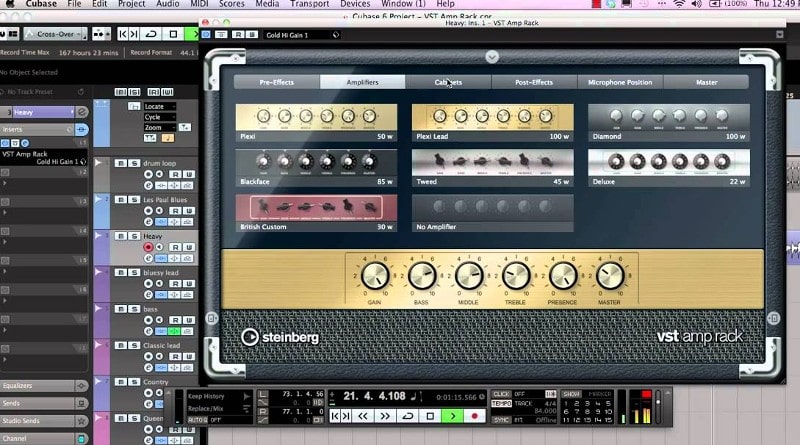
You can use standalone software or a DAW (digital audio workstation) to play your guitar. However, for this method, you will need an audio interface.
An audio interface is a piece of hardware that acts as the middleman between your guitar and the computer. You plug your instrument into it via an instrument cable and it converts the signal to a recognizable format for the software on your computer. These are usually available at many different price points and depending on your need, you can get a hold of a single or a two-channel interface well within your budget. Interfaces not only enable you to record the signal but can also be used as monitors for your instrument.
Most audio interfaces generally work with both macOS as well as Windows machines.
If you have a guitar or an interface, you will also need dedicated software or a DAW. There are many different kinds available, both free and paid and you can choose one depending on your requirements. If you already have a DAW, you can either use the inbuilt amp plugins or download external ones.
Read our review of some of the best amp plugins and standalone software here.
Smartphone Or Tablet
Improved! – Build a Portable Amp From Your Android Phone
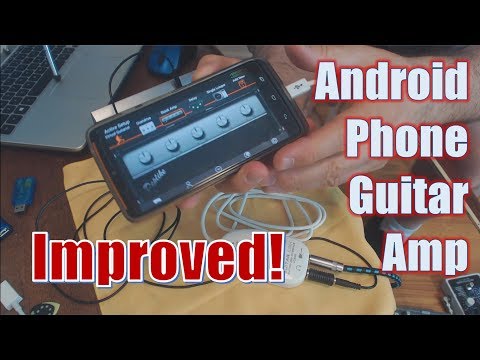
Watch this video on YouTube
Just like computers, you can also plug your guitar into a smartphone or tablet to produce sound. For this method, you will need a pair of headphones or external speakers along with an audio interface.
For Apple users, iRig by IK Multimedia is one such device that lets you plug your guitar into your phone or iPad. It has an input jack for your guitar and an output jack for headphones or speakers. The connector at the end converts the signal from your guitar for your phone and tablet. You can use software such as AmpliTube for iOS or a DAW like Garageband to then select an amp and produce sound.
iRig and AmpliTube are also available for Samsung devices.
If you are an Android user, there are similar brands with produce compact hardware that can be used for guitars and other instruments.
To hear the sound clearly, it is recommended that you plug a pair of headphones or speakers into your device because generally the inbuilt speakers on phones and tablets aren’t that great for guitar tones.
Compact-Sized Amplifiers
 Boss Katana Mini
Boss Katana Mini
There is a common misconception that amps always have large cabinets and produce a lot of sound. There are many different pocket-sized and travel-friendly amps that are great for practice. They are loud enough so you can hear what you are playing without causing a disturbance.
Some brands make models that can be directly plugged into your guitar. These are generally inexpensive and depending on which one you get, many models even have effects such as reverb and delay. Brands such as Vox and Blackstar make pocket amps like these.
Brands such as Marshall, Boss, Orange, Fender, etc produce ‘micro’ versions of their full-stack amplifiers. These generally require a 9V power adapter or batteries to run. The principle behind these is the same as the full-sized amps. You plug your guitar into them via an instrument cable and then make adjustments to your tone using the controls on the amp or amp head, where applicable.
The reason micro-amps are so popular is that you get the tone that these brands are generally known for. Some even have drum machines and metronomes which can be very helpful if you are looking for an amp to practice with.
Headphones and Headphone Amps
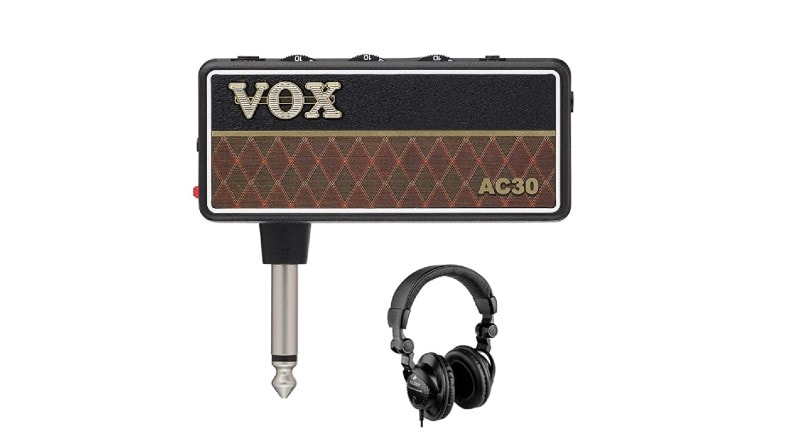 headphone amp
headphone amp
Although you cannot connect your guitar to a pair of headphones directly, even with a converter, there are a few ways to go about it.
If you already have an amp, there are high chances that it may have a headphone output. You can connect a pair of headphones to your amp if you want to hear yourself without depending on the speakers of your amp (check out our favorites here).
Just like most modern amps, micro amps also have a headphone output.
If you are using an interface to connect your guitar to a computer or a mobile device, you can plug your headphones into the interface to hear yourself. However, in this method, you still need software or a DAW because the guitar, by itself, does not generate an audible enough sound.
The Boss WAZA-AIR is a dedicated headphone amp that lets you connect your guitar to a wireless device that transmits the sound directly to the headphones. You can choose between different settings and make adjustments to your tone. There is also an inbuilt tuner.
However, at its price point, it is not the most practical solution.
When using headphones, remember to pick a pair that has a balanced sound. Studio headphones come in various budgets and although they can seem like an investment initially, a good pair goes a long way and lasts for many years. To know more about similar devices, read our review of some of the best ones available here.
External Speakers

Studio monitors are great substitutes for guitar amps because they have a flat sound and using a plugin and an audio interface you can sculpt your tones to emulate the amp of your choice.
Just like headphones, you cannot plug your guitar directly into the speakers. You will need an audio interface and relevant software.
Apart from studio monitors, you can also use surround sound speakers or home theater systems.
Devices such as Line 6’s ‘AMPLIFi TT’ allow you to plug your guitar into them and then hear the sound via headphones or external speakers. These do not require software and you can tweak your sound using the different controls on the device itself.
Effects Units
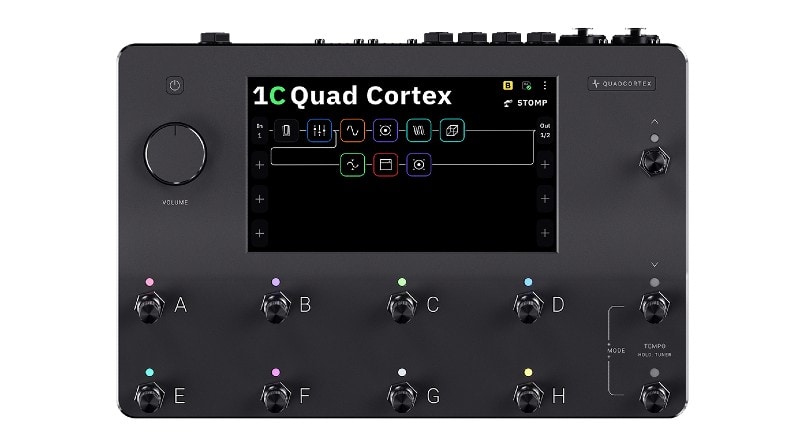 Neural DSP Quad Cortex
Neural DSP Quad Cortex
Most multi-effects units and rackmount effects generally have an output for headphones. You don’t need an amp to hear your tones when you plug your guitar into them. These can be extremely useful not just for practice but also to hear yourself when you are sculpting and saving your tones.
While rackmounts such as Fractal Audio Sytems’ ‘AXE FX’ can be expensive, there are many multi-effects units available at different budgets. For budding guitar players, these are good investments because they save the cost of buying multiple effect pedals and make for a more compact rig.
All multi-effects units and rackmount effects need a dedicated power supply to run. If you are an absolute beginner, then they can make for an expensive initial investment.
Semi-Electric Guitars
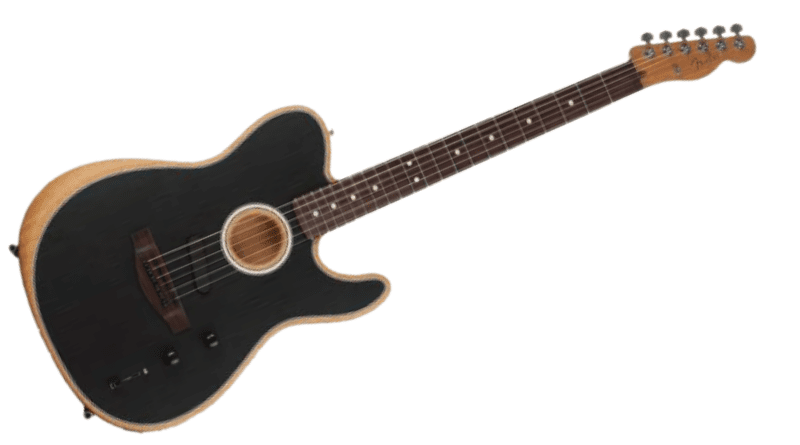
Hollow-body or semi-acoustic guitars give you the best of both worlds. You have the option to plug them into an amp, but you can also play them without one.
The sound is produced from the ‘f’- shaped holes in these guitars and although they are best suited for genres such as jazz, blues, and even rock they can come in handy if you want to play guitar but don’t necessarily feel like plugging one into an amp.
Many brands produce these semi-electric/acoustic guitars, Gretsch being an example of quality guitars at a reasonable price.
But of course, these aren’t the most versatile guitars and if your inclination is towards heavier genres such as metal then these might not be the best fit for you.
P.A. Systems
Public Address (PA) systems comprise a mixing desk, loudspeakers, and sometimes even amplifiers and monitors. You can generally plug your guitar into the mixing desk directly via DI boxes. However, even with a multi-effects unit, it is not recommended that you plug directly into a PA System because the amp is responsible for your guitar’s tone to a certain extent and the settings on it can be adjusted according to the space.
These are generally found in music venues and are often too loud for homes. But in case you find yourself at a gig with no amp, you can simply plug your guitar directly into the PA system. If you have a muli-effects unit then you will probably need to make adjustments to the tone if you want the sound of your guitar to cut through among other elements.
Guitars With Built-In Amps
How To Make A Home Made Guitar With Built In Amp
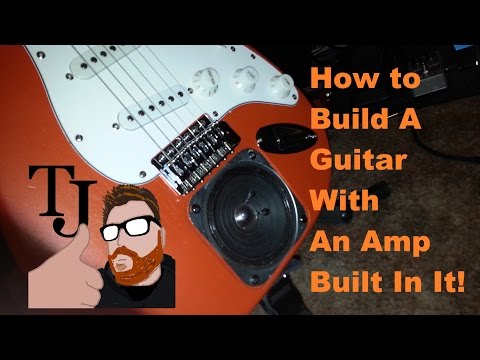
Watch this video on YouTube
While these are generally rare, there are a few models such as ElectroPhonic’s Model One and Pignose’s PGG-200 have built-in amps that can be powered using batteries. Although the sounds from these guitars are not very loud, they can be used for practice or in situations where there is no electricity.
However, these are generally seen as novelty guitars and are not as commonly used by musicians.
Commonly Asked Questions:
Can I plug headphones directly into my guitar?
No. although you can plug your headphones into the output jack of your guitar with a converter, your guitar will not produce any sound because the pickups are not converting the vibrations to an audio signal that produces the sound.
How expensive are amplifiers?
Amps come in a variety of sizes and budgets. While amp heads with larger cabinets tend to cost more, there are many budget-friendly, smaller-sized ones as well. Read our review of some of the best ones under $100 here.
How does an amp produce sound?
An amplifier takes an input signal from an instrument and increases the sound by making multiple copies of it and adding it back to the original. This enables us to hear the signal from the instrument loud and clear. Larger amps typically require more electricity to amplify the input audio signal whereas pocket amps can even run on batteries.
Can I plug an acoustic guitar into an amp?
If your acoustic guitar has a pickup then yes, you can plug it into an amp. This is because while acoustic guitars can produce sound by themselves, the pickups convert the vibrations from the strings to an electrical signal. This signal gets amplified when it is plugged into an amp or audio interface.
What Is A Headphone Amp?
A headphone amp takes an audio signal from an instrument such as an electric guitar and converts it into a soundwave within the speakers in the headphones. This thus works as a low power amp and allows you to hear the instrument.
Final Thoughts on How To Play Guitar Without An Amp
There are many reasons why you may not want to plug your guitar into an amp at all times. If you are worried about the volume then you should invest in a micro/mini amp because you will be able to hear yourself without fatiguing your ears or bothering others too much.
If you are inclined towards music production, then you should invest in a good audio interface. You will be able to play and record not just guitars but other instruments and vocals as well.
For those who already have an interface and a computer or a tablet, invest in a good pair of headphones or studio monitors for crystal clear sound.















![Toni Kroos là ai? [ sự thật về tiểu sử đầy đủ Toni Kroos ]](https://evbn.org/wp-content/uploads/New-Project-6635-1671934592.jpg)


